Designing a McLaren is about creating "efficiency through the air"
Interview: Robert Melville, chief designer at supercar brand McLaren, explains how bird wings, artificial hearts and spy planes are among the inspirations for vehicles where "everything is there for a reason" (+ slideshow).
Melville, recently promoted to chief designer, spoke to Dezeen at McLaren Technology Group's headquarters near Woking in England.
He explained how McLaren Automotive, the production car division of the group, distils the ethos of the McLaren Formula 1 team into high-performance road vehicles.
"Our mission statement is to be the iconic sports-car company," he said. "I see the brand identity as being born on the track. Everything is there for a reason. There's no excess; it's a purist statement."
McLaren was founded in 1963 by New Zealand-born racing driver Bruce McLaren. Its Formula 1 racing team was the first to introduce a carbon fibre chassis and the production cars also use the lightweight material.
"As a brand I like to think about where it started: the vision, ambition and determination of Bruce McLaren and how that led to new solutions on the race track," said Melville, 37.
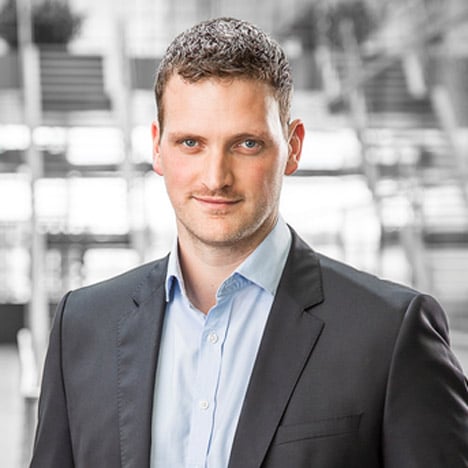
Signature elements of McLaren's design approach include biomimicry, layering and shrink-wrapping, Melville said.
Biomimicry and layering involve creating highly complex surfaces where the air flows not just over the car but through it, by creating layered surfaces like the wings of a bird or the gills of a fish.
"If you look at the way that fish move through the water and the water is going in and out - that's what we aspire to," Melville said, adding that his team is exploring how to create shape-shifting "transformer" cars that adapt to different driving conditions in urban, rural and race-track situations.
Shrink-wrapping involves ensuring that every inch of space inside the car's shell is utilised in the optimum way. "There's no space in there even to put a matchbox," explained the designer.
"The form equals the function," Melville said. "There's no excess left in it. It's a very pure statement: the radiuses grip the air where it's required; there are sharp edges on the panels where they need to detach the air."
"The ultimate comparison would be SR 71A Blackbird [spy plane]. It's a beautiful object and it's purely functional."
Last year McLaren produced 1,680 cars, all of which were hand built at its Foster-designed McLaren Production Centre in Surrey, southern England. Its range includes the P1 hybrid supercar and the new 650S, which is based on the car that won the 24 Hours at Le Mans race in 1005.
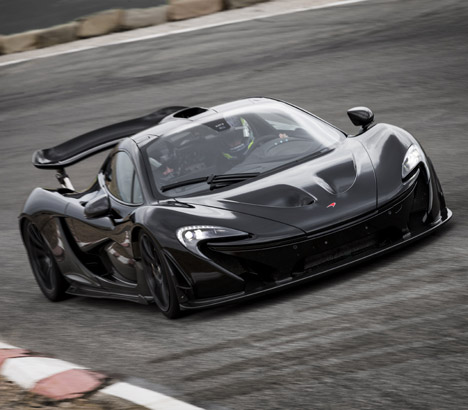
Here's an edited transcript of the interview from our interview with Robert Melville:
Marcus Fairs: You've just been promoted from senior designer to chief designer at McLaren. What are your responsibilities now?
Robert Melville: I'm taking a more overall view of the department. I'm responsible for advanced design, production design, design identity, design research, strategy… and also within those elements I've got more of a control over the clay teams [who create full-size prototypes in clay] and the CAS [computer-aided surfacing] teams.
The engineering here is a little bit different. In a normal engineering studio, designing would fall under a chief designer's wing, but here it's such an open relationship and they all sit in the same room as us anyway working on projects. It's this sort of total design mentality. It's not them and us.
Marcus Fairs: How many people do you have in your design team?
Robert Melville: There are eight designers. The clay team fluctuates, but that's anything between five and ten. And on the CAS side, that can fluctuate between ten and twenty. We've got three studio engineers and then the concept engineering group. But the engineers are under a separate control.
Marcus Fairs: Where do go to you hire young automotive designers? What are the top schools?
Robert Melville: Coventry University is great for bachelors and they do an MA course. Also the Royal College of Art, Pforzheim University in Germany, Umeå Institute of Design in Sweden. And then there are some schools in Italy, but I've not really used those so much. Then you look over to America and you've got CCS [College of Creative Studies] in Detroit and you've got Art Center in Pasadena. We tend to use those ones.
Marcus Fairs: Where did you study?
Robert Melville: I studied transportation design at the Royal College of Art. Land Rover sponsored my studies so after graduating in 2003 I went to work for them for three years. I helped contribute to a few projects like the current Land Rover and the Range Rover Evoque. I joined during the advanced design phase. It was really nice to see that work come to fruition. Evoque has been a big success for Land Rover.
After that I was at General Motors in the UK. Again it was advanced design - we did Cadillacs, Hummers, Buicks, Corvettes. The highlight there would have been being part of the team working on the Cadillac Converge in 2009.
And then I was lucky enough to get a phone call from Frank [Stephenson, McLaren's director of design and an automotive design legend, who previously worked as design director at Fiat, Alfa Romeo, Ferrari, Maserati and MINI]. So within about three days I had been down to McLaren for an interview and then that's how the whole relationship started.
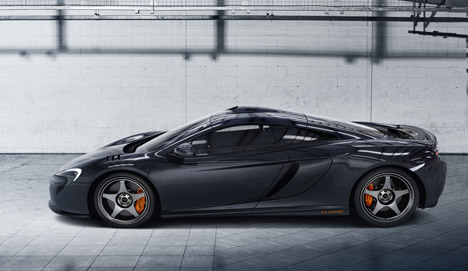
Marcus Fairs: Does the design process at McLaren differ substantially from other car brands you've worked at?
Robert Melville: We all have the same questions. As a car company, it's generally about efficiency and then how you improve the attributes of that brand. At Land Rover we had clear, functional, technical solutions to solve: how do you go from A to B across very rough terrain?
For McLaren it's obviously about efficiency through the air. So the questions aren't identical in that case, but in terms of how you slice through the air, what your tyre tractions are and the technical side of things, we are the same.
When I was at Cadillac - as good as the cars are now - often when you were drawing it became about trying a different line just to find the new shape. It wasn't that it benefitted the functionality of the vehicle. It was more that it was the latest style. Whereas at McLaren and companies like Land Rover it's more about the form and function.
It's like a race car. The form equals the function. There's no excess left in it. It's a very pure statement: the radiuses grip the air where it's required; there are sharp edges on the panels where they need to detach the air. So you can look around the object and see the way it interacts and the way it flows through the air - or through the water if it's a boat, etc.
The ultimate comparison would be SR 71A Blackbird [spy plane]. It's a beautiful object and it's purely functional. If we can one day get a car to be that level of design - and I know the SR 71A wasn't designed in that sense of the word; it was engineered. It's engineering design.
Marcus Fairs: How many cars do you produce each year?
Robert Melville: Last year we made 1,680 cars and I think 284 of those were P1s.
Marcus Fairs: And are they all made here?
Robert Melville: Yeah. Engineered, prototyped - so that's experimental prototypes, validation prototypes - all the design works, the whole clay process, sketching the CAS, the A surfacing is all done here. From the ground up it's all engineered here. Our paint facility is here.
It is done in a very bespoke manner. It's not machines putting the cars together. It's hand done. And I think it allows us to keep a flexible factory, so as you do introduce new models and phase other ones out, it is easy for us to adapt and meet the requirements. And as a customer I think it's great to be able to see that personal level of detail you get in very expensive products.
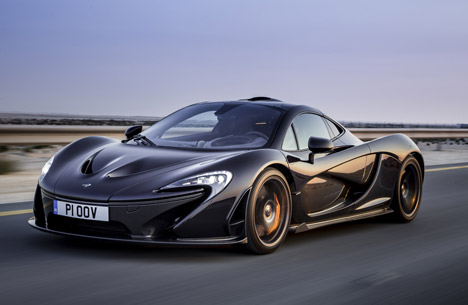
Marcus Fairs: What is the design DNA of McLaren?
Robert Melville: We produce iconic sports cars. Our mission statement is to be the iconic sports-car company. As a brand I like to think about where it started: the vision, ambition and determination of [McLaren founder, the race-car driver] Bruce McLaren and how that led to new solutions on the race track. I see the brand identity as being born on the track. Everything is there for a reason. There's no excess; it's a purist statement.
But beyond the identity we've got a visual language. Everything is there for a reason. For me, good design is telling the story visually. When you look around the car it's telling this narrative and you think: "Okay, I can see that the air hits here and it is split in two". So the functionality starts to inform the shape of the vehicle.
We shrink-wrap; we use biomimicry, lightweight materials, layering. I think it's becoming a bit of a trend; I see the BMW i8 has got some layering. Obviously with the Formula 1 cars it has been there a long time, and in the animal kingdom it has been there a long time, with gills and feathers.
But we have the ability to manufacture such complex shapes. Often, when you add complexity, you add weight. So for us it's complexity to improve functionality, but then also our use of materials and processes to still keep the weight down. In terms of materials, the core of our products has been the carbon tub.
Marcus Fairs: Tub, did you say?
Robert Melville: Yes. It's almost like a bathtub.
Marcus Fairs: That's not very glamorous! Is that really what you call it?
Robert Melville: Yeah. So the carbon tub, or the monocoque, or, on the P1, the monocell chassis. It's what we're famous for. And it all builds from this inside-out mentality. Obviously we're using the carbon fibres for their light weight and strength.
In Formula 1 we were the first team to use carbon fibre, and we've always been specialists in it through McLaren Applied Technologies. So lots of companies come to us for advice on that, and I think we always are going to remain at the cutting edge of carbon fibre and whatever will be the next step in lightweight performance materials.
Marcus Fairs: How do you design a McLaren? Do you start by sketching?
Robert Melville: In the past I would sit there and sketch, not quite in a trance, but in a zone. And you're sketching away, looking for new shapes to try and capture an emotion that you think is on trend or is correct for the market at that time, but which suits the brand.
But here at McLaren when you're sketching, you need to sketch the package [the predetermined elements of the car including engine, drivetrain and the position of the occupants] to start off with. You need to understand that the radiators are here, and the rear wing is this, and the occupant's cell is this shape to improve air ingress and egress. You're thinking from the inside out more. And you're building up the package and the story in your mind. You need to understand that before you even sketch. Once you've understood the package you can start to look at the form.
We have some brand DNA: certain lines and certain things we do so that the silhouette stands out in the street, so you can tell it's a McLaren because we've done this with the DLO [daylight opening - the distinct graphic form of a car's side windows] down to the fender lines, and the nose shape, and the rear-end graphics cues which become that visual identity.
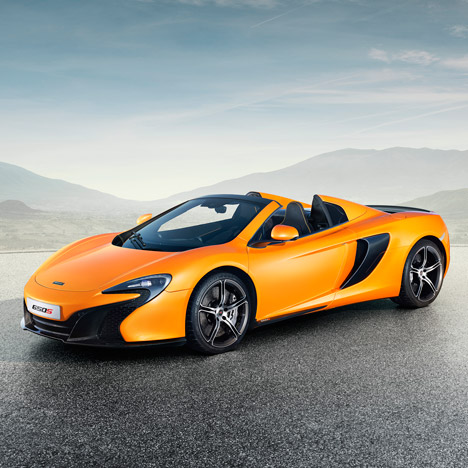
But then, as you get nearer to the car and you look at how the air flows around it on the leading edges of the ducts that cool the radiators where, rather than using a sharp radius, we use a bullnose radius, and that helps to keep the air attached. And by keeping the air attached it keeps it very energised, which then means the radiators can be kept smaller, because the air flow is more efficient.
So you start to minimise the package; you start to squeeze everything down. If you can squeeze the radiators and make them smaller there's more space to drop the lamps down to the legal limit. Everything has been squeezed down, ultimately with the target of decreasing the frontal area of the car. And that's just lie when you stick your hand out of the car window as a kid and you feel it resisting all that air, but if you turn your hand sideways you're decreasing the frontal area so it becomes super efficient.
So for us, by designing from the inside out and thinking about the occupant, you squeeze the cabin down and then that frees up space on the shoulders of the car, which is where we take air in on the P1. And the reason for that is purely because that's where the highest energy air comes. In terms of efficiency it is the best place. If you look at Le Mans cars they're all shoulder fed. So we've applied that to road cars, which means you've got very complex doors, which gives you a unique look.
So we can tell this whole story: designing from the inside out, decreasing frontal area, and making the most of that highly energised air by using sections in the design which help the air to attach.
Marcus Fairs: When you talk about biomimicry, what do you mean? Are McLarens literally influenced by eagles or sharks or whatever, or is it more of an approach?
Robert Melville: It's more of an approach. The mechanisms on the rear wing of the 650S work the same way a bird wing, whereas the radii and the bullnose sections I was talking about, you see those on whale sharks. It creates a story that people can understand.
Actually, just recently I was really inspired by a guy who had had a heart transplant and instead of a pacemaker they swapped his heart out for an open pump, which produced a constant flow of blood, so it had no heart beat. The doctors have improved nature. They think it's a better, more efficient design. There's less wear and tear. So in terms of that grander sort of philosophy, that's what we try and do. You look at nature and ask how can you improve it.
Marcus Fairs: What do you mean by shrink-wrapping?
Robert Melville: When you take the panels off of the P1, the package - the radiators, condensers, the wiring etc - is so squeezed down. Everything is so well packaged. It's amazing work. There's no space in there even to put a matchbox. So that's shrink-wrapping. There's the package and we shrink-wrap the surfaces over the top. That gives you the efficiency.
You can pull the rear end of the car down very low, which is brilliant for reducing drag and getting more downforce. You're creating a teardrop, effectively, in side view. Again, you see it on Le Mans cars. But on road cars, generally, no one has ever gone as low as a P1. That's extreme. We brought it off the racing track and applied it to a road car.
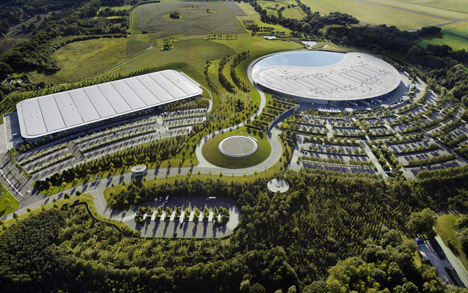
Marcus Fairs: What's layering?
Robert Melville: Layering is where rather than having very full, heavy sections, we're thinking about the B surface and how that interacts with the next surface. It implies that you have removed all the fat, all of that excess weight. So it's a step towards Formula 1 language.
It means that you've got double the number of A surface panels because now you can look underneath. So you have the A surface, which is the visual bit you'd normally see on any road car, and then the B surface, which is normally not nice and is not finished to the same standards. But we have to design the B surface as well. So it adds more work, but by doing that I think it really helps to communicate that we've taken the weight out. It's a lean machine. It's almost like a motorbike.
Marcus Fairs: So, in layman's terms the B surface is the inside of a panel?
Robert Melville: Yeah. The underside of the bonnet, for example, or the door. You'd never normally have a door in two pieces, but on the McLaren you do. You've got these separate slices on a P1, so you can see the inside, the outside, and when you open the door on a P1 as well, you can look down the sill and there's actually another hidden duct which helps feed more air from the front radiators. It calms the air back down again and feeds the air into the side radiators.
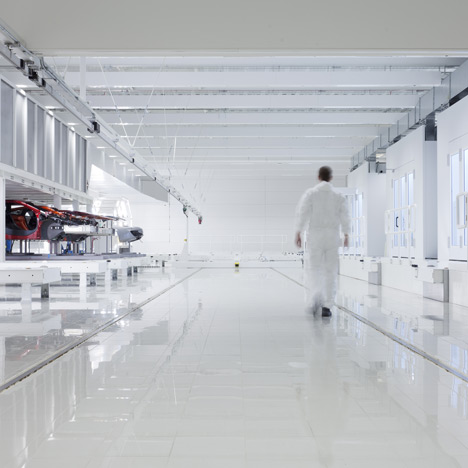
Marcus Fairs: So the air isn't just flowing over the visible surface of the car. It's flowing through the car.
Robert Melville: Yeah. And that's where the biomimicry comes in. If you look at the way that fish move through the water and the water is going in and out - that's what we aspire to.
Marcus Fairs: Is McLaren the only car manufacturer that does that?
Robert Melville: There's been elements of it other cars. Obviously, when you have a normal wing, air going underneath and over the top, and companies like Ferrari have used diffusers along the underside of the car. But we are the first ones to apply it onto a door and down the sills. It's definitely unique to us.
Marcus Fairs: What is the future for car design? If you take biomimicry to its logical conclusion, cars would change shape. A bird has a different shape if it's standing on the ground or if it's flying slowly, or flying fast. A McLaren is at optimum performance when it's at top speed, which most of the time it isn't. Do you think there will be transformer elements to cars? BMW experimented with that, with their shape-shifting fabric car, didn't they?
Robert Melville: Yeah, the GINA. Definitely. "Transformer" is actually a key word that we use in the studio. And I think the way that we've already show that on the P1. When the P1 goes into track mode it drops 50mm and the rear wing deploys to provide 600 kilos of downforce. Ferrari and Porsche have track modes too but the aerodynamic element and the way the car changes its character from road to track was definitely the greatest in the McLaren.
Marcus Fairs: So the car changes shape?
Robert Melville: Yeah. And, ultimately, when we're looking down the road at future projects and advanced design, clearly, the sky is the limit. I think for me, ultimately, if we can have a car that can truly change its character from the city to the country road to the track, McLaren will still relevant in the future, if cars become autonomous and if that starts becoming a law.
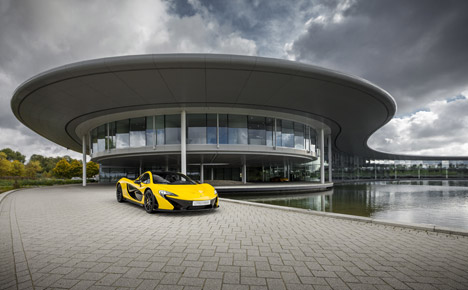
Marcus Fairs: So you're thinking about how you'd respond if self-driving cars became compulsory?
Robert Melville: How do we solve those problems? Because we'd still need to sell our cars. We'd still need to let people enjoy the thrill of driving. So maybe you're autonomous in the city and as you come out into the countryside the car changes. But the McLaren is not just changing its software setting; it's changing its geometry and its functionality. And then, if you want to go to the ultimate extreme, you go to the track and it changes again.
Marcus Fairs: That's an interesting point, because when people talk about autonomous vehicles, you tend to be imagining blob-shaped urban cars that you sit in and work on your laptop or watch TV. But you wouldn't want to do that in a McLaren.
Robert Melville: You wouldn't, no. If something like that became legislation, it would be a very interesting challenge and in the design team we are already thinking about what that would mean. As a technology group, we can apply all of the lightweight engineering - the efficiency, the frontal area - to a city car as well as a track car.
Marcus Fairs: Cars have increasingly sophisticated electronic driving aids. Even the engine sound is computer-enhanced in some cars. Is technology taking away the visceral thrill of driving?
Robert Melville: I think as long as you've got the option to turn [driving aids] on and off… Maybe you're going on a long drive to the south of France and you think: "The weather isn't great. I'll leave all the driving aids on." It's not about racing; it's about getting there comfortably and safely.
But you might want to go to the track later, and you might want the full visceral experience. You want the engine to sound as loud as possible. So we can let more sound into the cabin from the engine. We can crank everything up and really give that feedback to the owner. So they get the best of both worlds, really.